Class Gastropoda
![]() Subclass
Patellogastropoda (Docoglossa)
Subclass
Patellogastropoda (Docoglossa)
![]() Superfamily
Patelloidea
Superfamily
Patelloidea
![]() Family Patellidae
Family Patellidae
![]() MARBEF:
Patella vulgata taxonomic information.
MARBEF:
Patella vulgata taxonomic information.
![]() Taxonomy of
Gastropoda: Clade Patellogastropoda: Patellidae.
Taxonomy of
Gastropoda: Clade Patellogastropoda: Patellidae.
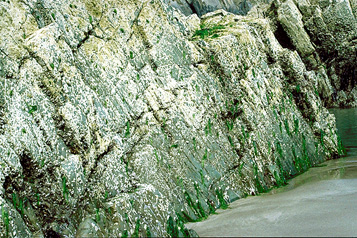 A rocky shore on the Atlantic: A typical habitat for limpets. Source: Morris, Currie: Rocky Shore Ecology. |
Limpets are easily to be found in places rich in algae on most rocky shores. Because of the cup-shaped shells, the small gastropods, most of which reach only few inches in size, are easily recognised. The shell may not look like a typical asymmetrical snail shell, but on very juvenile limpets' shells rests of the coiled shell spire can still be found. The cup-like shape of a limpet's shell means an adaptation to their living space on the rocky shores of the sea, the so-called littoral or tidal zone. Here limpets living higher on the rocks have higher shells, than those living more deeply in the sea. They fall dry during low tide and their higher shell protects them by allowing a larger reserve of breathing water. On the other hand, the flatter shells of limpets living further below do not present as much resistance against the huge forces of the surf.
Limpets are herbivorous animals feeding on algae the scrape off the rock they live on. The slime trace they leave behind help them in not visiting the same place twice. Besides, limpets' slime helps in supporting algae growth, so the limpet also sees to the restoration of its food source.
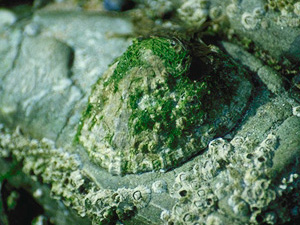 A limpet on its habitual resting place. Source: Morris, Currie: Rocky Shore Ecology. |
Limpets also defend their pasture ground against other limpets by trying to drive them away ramming their shells. Barnacles and mussels competing for food are removed by using the shell rim like a bulldozer.
A limpet's shell is also used as defence against carnivorous snails like whelks trying to drill into their prey's shells. The limpet tries to fight against the attacker by trapping the whelk's foot under the shell rim. Who ever tried to remove a limpet without any tools, will know what kind of force those small gastropods can employ clinging to their rock.
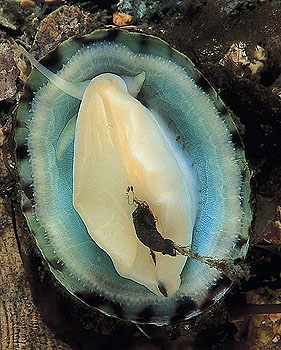 Ventral view of a limpet (Patella vulgata) Photo: Erling Svensen. The mouse pointer shows the different body parts. |
When there is a low tide, limpets return to their habitual resting places. Limpets' resting places can be recognized by the round traces they made by engraving their shells into the rock's surface. That way the limpet can attach itself especially hard to the rock surface and so has got the best possible protection against the surf.
Looking at a limpet's ventral side, the first thing to catch one's eye is the large, usually circular, sucking foot.
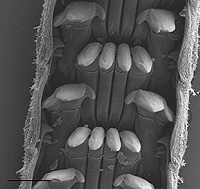 Radula of the limpet Patella rustica. Picture: Salzburg university, with friendly courtesy. |
On a limpet's front end there is the head with two tentacles. The largest part of the shell's inner side in covered by the mantle (pallium), whose seam is full of smaller tentacles. Between mantle and foot there is a groove full of gills. A limpet's gills are placed in single filaments behind each other in the pallial groove. Like among chitons this is an adaptation to the oxygen supply running low when the limpet clings to the rock.
The multitude of a limpet's gill filaments may be a developed character, but as such limpets are a rather archaic gastropod group. This can especially well be seen regarding the composition of their radula, which is called docogloss. The first part of the word means "beam", the second "tongue". This describes the rigid shape of a limpet radula with few lateral toothlets and hardened intermediary plates.
Another limpet of the Patellidae family is the blue rayed limpet (Helcion pellucidus), though it does not look like its larger relatives with its translucent shell only 0.5 to 1.5 cm long. Blue rayed limpets live on kelp plants, such as Laminaria, on the blades of which it feeds, leaving tiny grooves.
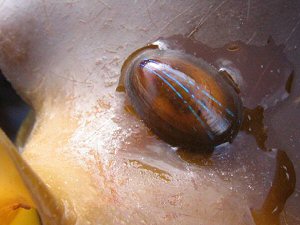 Blue rayed limpet (Helcion pellucidus) on a blade of Laminaria kelp. Picture: Florence Gully, Nature 22 Gastéropodes 1. |
The blue rayed limpet is rare in the Mediterranean, it is only found on the Moroccan coast and on the Spanish coast near Gibraltar. On the French Atlantic coast the snail is more frequent, it is found on Laminaria kelp, sea spaghetti (Himanthalia elongata) and Fucus serratus kelp.
Rather different from its soberly coloured relatives, the blue rayed limpet bears three strikingly blue stripes all over its shell (hence its name).
In English there are several gastropod groups that are called limpets. Besides the limpets as such (Patellidae), there are also keyhole limpets (Fissurellidae), which are much more highly developed. In contrary to them, real limpets never have a hole in the peak of their shells. But dead limpets' shells may be abraded by the sea, so holes can be found in limpet shells afterwards. Finally there are also the slipper limpets (Calyptraeidae). Apart from belonging to a completely different systematic group of gastropods, those sea snails only vaguely resemble a patellid limpet.